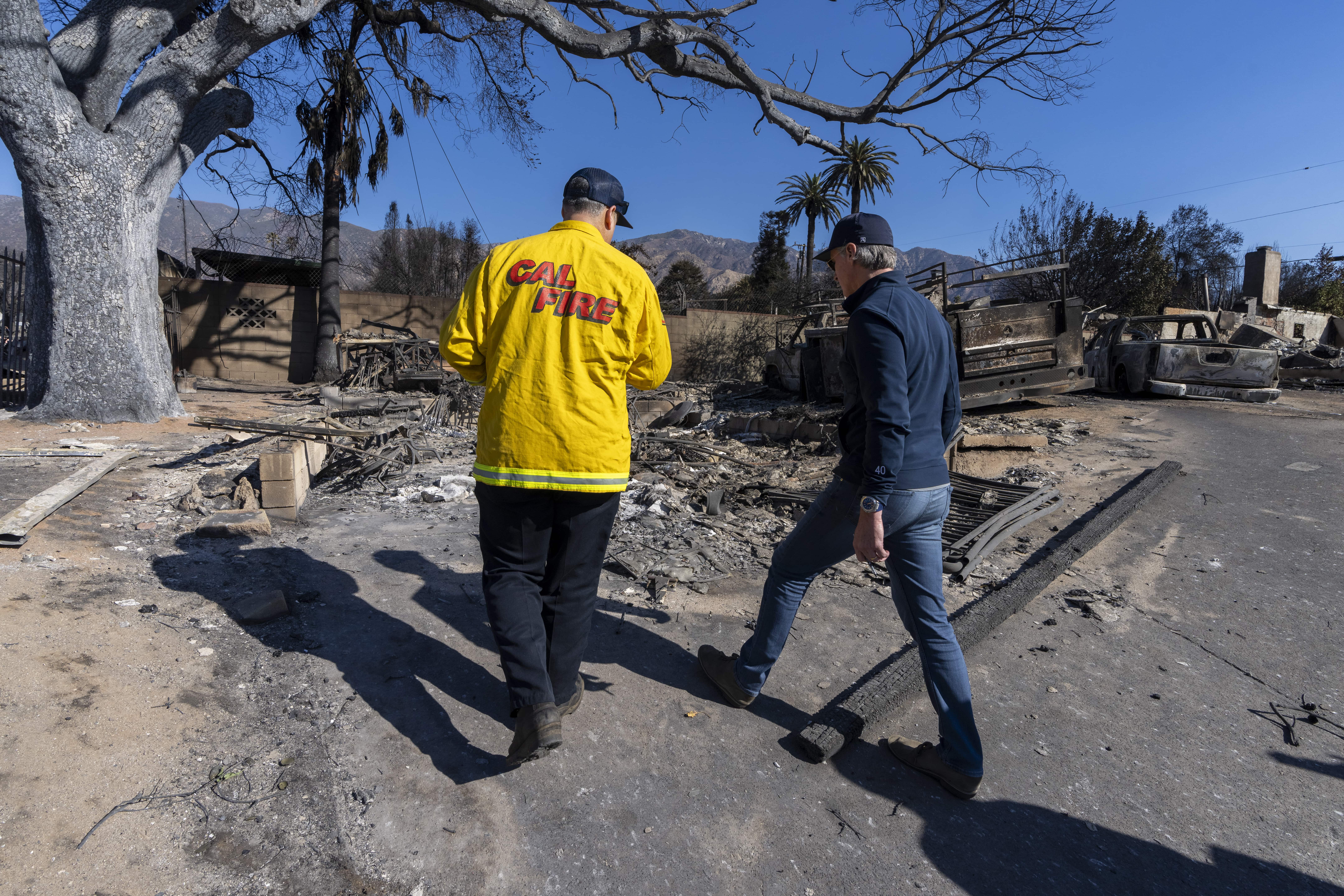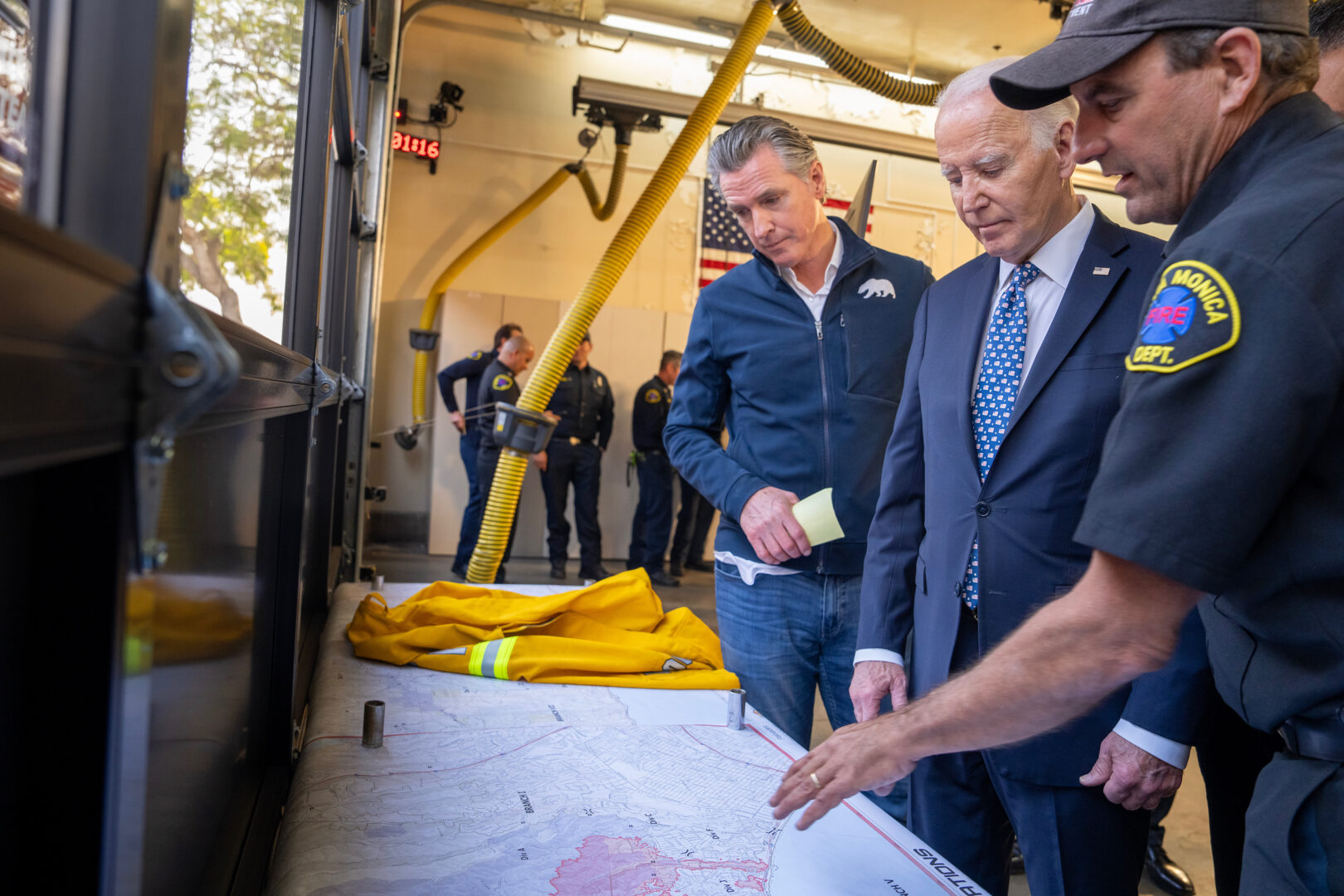Here are all the actions Governor Newsom has taken in response to the Los Angeles fires
See actions by day
Launched historic recovery and rebuilding efforts — faster than ever before

- Cutting red tape to help rebuild Los Angeles faster and stronger. Governor Newsom issued an executive order to streamline the rebuilding of homes and businesses destroyed — suspending permitting and review requirements under the California Environmental Quality Act (CEQA) and the California Coastal Act. The Governor also issued an executive order further cutting red tape by reiterating that permitting requirements under the California Coastal Act are suspended for rebuilding efforts and directing the Coastal Commission not to issue guidance or take any action that interferes with or conflicts with the Governor’s executive orders. Additionally, he signed an executive order to cut more red tape and continue streamlining rebuilding, recovery, and relief for survivors. The Governor also issued an executive order removing bureaucratic barriers, extending deadlines, and providing critical regulatory relief to help fire survivors rebuild, access essential services, and recover more quickly.
- Providing tax and mortgage relief to those impacted by the fires. California postponed the individual tax filing deadline to October 15 for Los Angeles County taxpayers. Additionally, the state extended the January 31, 2025, sales and use tax filing deadline for Los Angeles County taxpayers until April 30 — providing critical tax relief for businesses. Governor Newsom suspended penalties and interest on late property tax payments for a year, effectively extending the state property tax deadline. The Governor also worked with state– and federally-chartered banks that have committed to providing mortgage relief for survivors in certain zip codes. For additional relief, Governor Newsom is sponsoring new legislation to allow homeowners who receive insurance payments for lost or damaged property to receive the interest accrued rather than lenders. The Governor is also proposing to create an over $125 million mortgage relief program to assist homeowners whose homes were destroyed or severely damaged by recent natural disasters, placing them at risk of foreclosure.
- Fast-tracking temporary housing and protecting tenants. To help provide necessary shelter for those immediately impacted by the firestorms, the Governor issued an executive order to make it easier to streamline construction of accessory dwelling units, allow for more temporary trailers and other housing, and suspend fees for mobile home parks. Governor Newsom also issued an executive order that prohibits landlords in Los Angeles County from evicting tenants for sharing their rental with survivors displaced by the Los Angeles-area firestorms.
- Mobilizing debris removal and cleanup. With an eye toward recovery, the Governor directed fast action on debris removal work and mitigating the potential for mudslides and flooding in areas burned. He also signed an executive order to allow expert federal hazmat crews to start cleaning up properties as a key step in getting people back to their properties safely. The Governor also issued an executive order to help mitigate risk of mudslides and flooding and protect communities by hastening efforts to remove debris, bolster flood defenses, and stabilize hillsides in affected areas. Governor Newsom joined federal and local partners to begin work on structural debris removal — just 35 days after the start of the fires, a record-breaking pace for cleanup.
- Safeguarding survivors from price gouging. Governor Newsom expanded restrictions to protect survivors from illegal price hikes on rent, hotel and motel costs, and building materials or construction. Report violations to the Office of the Attorney General here.
- Directing immediate state relief. The Governor signed legislation providing over $2.5 billion to immediately support ongoing emergency response efforts and to jumpstart recovery efforts for Los Angeles. California quickly launched CA.gov/LAfires as a single hub of information and resources to support those impacted and bolsters in-person Disaster Recovery Centers. That website features a dashboard tracking recovery efforts and a recovery services finder to help connect survivors with help. The Governor also launched LA Rises, a unified recovery initiative that brings together private sector leaders to support rebuilding efforts. Governor Newsom announced that individuals and families directly impacted by the recent fires living in certain zip codes may be eligible to receive Disaster CalFresh food benefits.
- Getting kids back in the classroom and supporting childcare providers. Governor Newsom signed an executive order to quickly assist displaced students in the Los Angeles area and bolster schools affected by the firestorms. Governor Gavin Newsom issued an executive order to ensure that childcare providers are aware of their potential eligibility for Disaster Unemployment Assistance and have the support needed to apply.
- Protecting victims from real estate speculators. The Governor issued an executive order to protect firestorm victims from predatory land speculators making aggressive and unsolicited cash offers to purchase their property.
- Helping businesses and workers get back on their feet. The Governor issued an executive order to support small businesses and workers, by providing relief to help businesses recover quickly by deferring annual licensing fees and waiving other requirements that may impose barriers to recovery.
Partnering with the federal government – across both administrations – to boost California’s rapid response

- At the Governor’s request, President Biden approved a Presidential Major Disaster Declaration to support ongoing response efforts. The Major Disaster Declaration has been expanded to support communities with repairs or replacement of firestorm-damaged public facilities and infrastructure.
- In a cell phone call from the firestorm, Governor Newsom requested from President Biden additional federal assistance to cover 100% of California’s fire management and debris removal costs for 180 days, up from the traditional 75%.
- Within the span of 12 hours, the Governor secured three Fire Management Assistance Grants (FMAGs) to help ensure the availability of vital resources to assist firefighting efforts on the Palisades, Eaton and Hurst fires.
- Governor Newsom traveled to Washington, DC to meet with President Trump and members of Congress — focusing on securing critical disaster aid for survivors and ensuring impacted families who lost their homes and livelihoods have the support they need to rebuild and recover.
Deployed unprecedented firefighting and first responder force – including early pre-positioning before the fire

- Governor Newsom ordered pre-positioned firefighting personnel and assets on Monday, January 6 – ahead of the severe fire weather that started on Tuesday, January 7. Pre-positioned assets included 110 engines and hundreds of firefighters in strategic locations throughout Southern California, including in Los Angeles. California also pre-positioned assets – including over 300 additional firefighting personnel and 135 additional engines – once again on January 12 in anticipation of a second round of severe fire weather.
- Governor Newsom deployed 16,000+ personnel at the peak of the response, including firefighters, California National Guard service members, highway patrol officers and transportation teams. These efforts were backed by the biggest state investment in fire response in history — nearly doubled since the beginning of the administration. Response efforts included more than 2,000 pieces of firefighting equipment, including 1,490+ engines, 80+ aircraft, 200+ dozers and 210+ water tenders to aid in putting out the fires. The Governor deployed a surge of California Highway Patrol Special Response Teams to provide ongoing law enforcement capacity to further protect fire damaged communities in Los Angeles.
- Governor Newsom ordered the activation of more than 2,500 California National Guard service members to augment firefighting operations and support local law enforcement to protect communities from looting. The Governor’s National Guard activation started with his emergency proclamation on Tuesday, January 7 with over 600 service members deployed. The Governor doubled the number of those deployed on January 11, and increased that by 1,000 the next day to a total of 2,500. Also strengthening public safety efforts, the Governor signed an executive order directing state agencies to support local law enforcement partners as they lift evacuation orders.
- Governor Newsom proclaimed a state of emergency on the first day of the fire, Tuesday, January 7, to support communities responding to the fires. He subsequently issued two executive orders to support response and recovery efforts.
Key actions by day
Monday, Jan. 6: Resources & personnel prepositioned in Southern California ahead of forecasted fire weather in the region.
Tuesday, Jan. 7: Immediately after the firestorms began, the Governor issued an executive order, declared a State of Emergency to support ongoing response, and announced federal resources have been secured for Palisades, Eaton, and Hurst fires.
Wednesday, Jan. 8: A Major Disaster Declaration was approved by President Biden, just 36 hours after the request was submitted, and as the Governor and the President received a briefing on the ground by CAL FIRE officials. The Governor also announced mobilizing up to 140 2,500-gallon water tenders to assist in the firefight.
Thursday, Jan. 9: During a briefing on the firestorms, President Biden and Vice President Kamala Harris announced 100% reimbursement rate by the federal government after a call with the Governor. The Governor deployed the California National Guard to assist with local law enforcement efforts.
Friday, Jan. 10: The Governor issued his second executive order, this one focused on public health; and the Governor called for a review of the local water distribution system.
Saturday, Jan. 11: The Governor announced the state is offering taxpayers in Los Angeles County a postponement on filing 2024 tax returns and making tax payments that would have been due between January 7 and October 15, 2025. Governor Newsom also announced he doubled the California National Guard deployment to aid in firefighting.
Sunday, Jan. 12: The Governor issued his third executive order, this one focused on streamlining rebuilding efforts; and his fourth executive order, this one directing fast action to clean debris and mudslides. The Governor also announced the deployment of an additional 1,000 California National Guard service members.
Monday, Jan. 13: The Governor announced tax relief to small businesses impacted by the LA firestorms, announced the expansion of special session to focus on relief efforts, and prepositioned emergency personnel ahead of another round of dangerous weather.
Tuesday, Jan. 14: The Governor issued his fifth executive order, this one focused on schools, prepositioned and mobilized debris clean up efforts, and issued his sixth executive order, this one focused on protecting people from predatory housing attempts.
Wednesday, Jan. 15: The Governor announced California has secured additional federal assistance through the Major Disaster Declaration, deployed additional CHP officers to protect public safety, and issued his seventh executive order, this one focused on clean up efforts.
Thursday, Jan. 16: The Governor issued his eighth executive order, this one focused on fast-tracking temporary housing, issued his ninth executive order, this one focused on property tax relief, and announced the availability of new federal funding for impacted workers.
Friday, Jan. 17: The Governor issued his tenth executive order, this one focused on protecting tenants from eviction.
Saturday, Jan. 18: The Governor announced that five major lenders will provide mortgage relief to their customers, and the streamlining of access to local, state, and federal resources.
Sunday, Jan. 19: The Governor announced the prepositioning of additional resources and personnel ahead of forecasted fire weather, and issued his eleventh executive order, this one focused on public safety efforts.
Monday, Jan. 20: The Governor volunteered with First Partner Jennifer Siebel Newsom at Project Angel Food to support survivors, announced efforts to reopen support services, and issued his twelfth executive order, this one focused on flood and debris flow.
Tuesday, Jan. 21: The Governor met with workers and small business owners impacted by the devastating Los Angeles firestorm to hear their stories and highlight the state’s work to help communities rebuild.
Wednesday, Jan. 22: The Governor announced the deployment of specialized debris flow teams to Southern California ahead of forecasted rainy weather.
Thursday, Jan. 23: The Governor announced additional commitments to provide mortgage relief for property owners whose structures were damaged or destroyed, adding state-chartered banks, credit unions, and mortgage lenders and servicers, as well as additional federally chartered institutions; bolstered online resources for survivors; signed $2.5 billion in relief to begin recovery and rebuilding efforts.
Friday, Jan. 24: The Governor announced $100 million (of the $2.5 billion) has already been moved to help with the recovery and rebuilding efforts; met with first responders at the front lines of the Hughes Fire; and welcomed President Trump to the Los Angeles area as part of the President’s tour of the impacted communities.
Monday, Jan. 27: The Governor issued his thirteenth executive order, this one focused on cutting additional red tape regarding the CA Coastal Commission and extended temporary housing stays to longer than 30 days.
Tuesday, Jan. 28: The Governor announced the launch of LA Rises, a unified recovery initiative that brings together private sector leaders to support rebuilding efforts
Wednesday, Jan. 29: The Governor issued his fourteenth executive order, this one supporting small business owners and workers.
Friday, Jan. 31: The Governor extended law enforcement resources, financial support, and mutual aid coordination to support local agencies in fire-impacted area.
Saturday, Feb. 1: The Governor highlighted efforts to protect survivors from price-gouging, and provided additional law enforcement support to keep the Pacific Palisades closed to non-residents.
Sunday, Feb. 2: Under the Governor’s directive, crews have been working around the clock to install nearly 60 miles of emergency protective materials in the recent Los Angeles-area burn scars to ensure communities impacted by the recent firestorms in Los Angeles are protected from upcoming rainstorms.
Tuesday, Feb. 4: The Governor signed a new executive order to cut red tape by suspending regulations and extending deadlines to assist in helping survivors recover quickly.
Wednesday, Feb. 5: Governor Newsom announced that individuals and families directly impacted by the firestorms may be eligible to receive Disaster CalFresh food benefits. In Washington, D.C, the Governor met with President Trump and and members of Congress to secure critical disaster aid for survivors.
Thursday, Feb. 6: Governor Newsom continued his bipartisan outreach in meetings on Capitol Hill with House and Senate leadership that focused on securing critical disaster aid for the survivors.
Monday, Feb. 10: Governor Newsom announced he is sponsoring new legislation to allow homeowners who receive insurance payments for lost or damaged property to receive the interest accrued rather than lenders. The Governor also announced that the state’s LA fires hub has a new dashboard tracking recovery efforts, as well as a new recovery services finder tool for survivors.
Tuesday, Feb. 11: The fastest large-scale debris removal in modern state history began in Altadena and the Pacific Palisades, in roughly half the time it took to start similar operations after the devastating 2018 Woolsey Fire. The Governor issued an executive order to ensure that childcare providers impacted are aware of their potential eligibility for Disaster Unemployment Assistance and have the support needed to apply. Governor Newsom and First Partner Jennifer Siebel Newsom surveyed ongoing work by state crews to prepare the Eaton Fire burn scar area ahead of rain, part of a whole-of-government operation to protect the state ahead of an incoming winter storm.
Wednesday, Feb. 13: The Governor signed an executive order to cut more red tape and continue streamlining rebuilding, recovery, and relief for survivors.
Wednesday, Feb. 19: The Governor announced a proposal to create an over $125 million mortgage relief program to assist homeowners whose homes were destroyed or severely damaged by recent natural disasters, placing them at risk of foreclosure.
[Last updated February 19]
